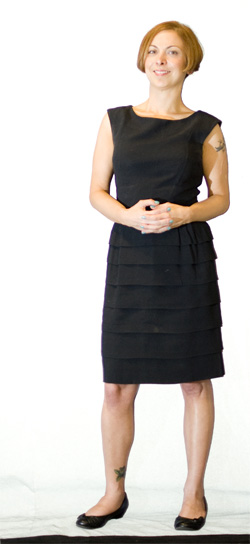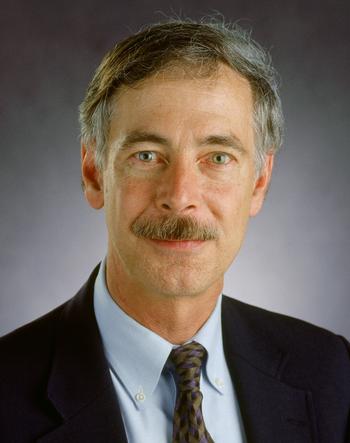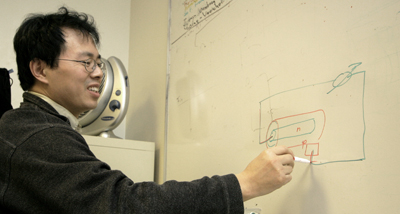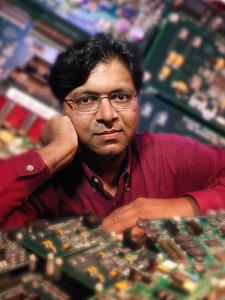Nineteen Projects Awarded Inaugural Calit2 Strategic Research Opportunities Grants
UC San Diego Researchers Target Culture, Energy, Environment and Health
San Diego, May 13, 2010 -- The first awards under a new research grant program at the University of California, San Diego will support a broad range of projects led by faculty members from 13 different departments and staff researchers participating in the California Institute for Telecommunications and Information Technology (Calit2).
|
All faculty and research scientists on the UC San Diego campus were eligible to apply for CSRO support, even those not previously affiliated with the multidisciplinary institute.
“Calit2 is approaching its tenth anniversary this December, so we viewed this as an opportunity to bring dynamic new academic participants into the fold,” said Calit2 UCSD Division Director Ramesh Rao, a professor of electrical and computer engineering in the university’s Jacobs School of Engineering. “In the end, that is exactly what happened: eight of the 19 funded proposals are led by relative newcomers to Calit2 at UC San Diego.”
|
‘What It Means to Be Human’
Saygin, an assistant professor who joined the cognitive science department last fall, will use functional magnetic resonance imaging (fMRI) to peer into the brains of test subjects as they interact with on-screen avatars. She is investigating “social cognition and interactive artificial agents.” Saygin hopes to provide a scientific basis for the “uncanny valley” – a phenomenon in robotics, computer graphics and animation.
As the theory goes, humans become more at ease interacting with avatars as they become more human-like. But when the avatars become too realistic (e.g., characters in the movie Polar Express), humans suddenly perceive the avatar as disturbing or negative – until the day when the anthropomorphism, thanks to improved computer graphics, becomes so complete that the brain returns to perceiving the avatar positively, as nearly human.
“We aim to improve our understanding of how the human brain enables social cognition, and to help engineers and designers develop interactive agents that are well-suited to their application domains as well as to the brains of their creators,” said Saygin, whose one-year project is budgeted at $54,000. “Thanks to the support from Calit2, we will be able to test how humans interact with a broad spectrum of avatars and to learn how the nervous system supports social cognition – an undeniably important skill and part of what it means to be human.”
And, according to Calit2 Associate Director Rajesh Gupta, who chaired the CSRO program committee, “understanding the critical man-machine interface is of crucial importance to better integration of emerging cyberinfrastructure to benefit society – a key aspect of Calit2’s charter.”
Each CSRO proposal was required to further one of Calit2’s four strategic application areas: culture, energy, the environment, or health.
Saygin’s project is one of six in the Culture category to get the go-ahead:
- Social Cognition and Interactive Artificial Agents, PI Ayse Pinar Saygin, Cognitive Science and Neurosciences;
- Supervisualization of Large Image Collections, PI Lev Manovich, Visual Arts and Director, Software Studies Initiative;
- Advanced Intermedia Telepresence, PI Mark Dresser, Music;
- The Provocateur Project, PI Shlomo Dubnov, Music;
- Innovation, Engineering and Exploration, PI Albert Lin, Calit2;
- Cyberinfrastructure, Portable NexCAVE and Archaeological Research, PI Tom Levy, Anthropology, and Associate Director, CISA3.
None of the cash in CSRO grants comes from taxpayers or the State of California. Calit2 is using gifts from industry partners and foundations. In-kind awards to the 19 projects – mostly in the form of staff technical support and use of specialized facilities such as the Nano3 clean rooms, circuits and visualization labs – will bring total Calit2 support to $700,000. (More information about the program is available online at http://csro.calit2.net.)
All projects seeking funding of $50,000 or more were required also to show matching funds for at least 25 percent of the total budget. Including those matching funds, the total budget for all CSRO-funded projects this round will reach $885,000.
“It has been gratifying to see the strength of so many proposals – strengths that made the judging process very difficult,” said Calit2’s Gupta, who is also a computer science and engineering professor in the Jacobs School of Engineering, as well as chair of the CSRO program committee. “We received project proposals totaling nearly $4 million, and there were many more projects we would have liked to fund but did not have the capacity to do so at this time. Some of those proposals could eventually be funded in future rounds, or we will work with the faculty to pinpoint other sources of support outside of the CSRO program.”
Making Smart-Phones More Energy-Efficient
All graduate student researchers to be funded by the program will become the inaugural class of CSRO Fellows. Two of the seven fellowships will work on the largest funded project: a study of real-time adaptive digital pre-distortion (DPD) for cellular communications, led by ECE professor Peter Asbeck and Calit2 principal development engineer Don Kimball. CSRO is covering half of the $150,000 budget, with the remainder in matching funds from Nokia Siemens Networks.
|
“DPD is almost an historical inevitability, since it leverages Moore’s Law to improve cell-phone characteristics,” said Asbeck. “This project will provide a road-map for DPD implementation on smart-phone handsets.”
“For the first time,” added Calit2’s Kimball, “the power consumption and low time latency of our DPD will catch the attention of the major cell phone providers.” If the technology proves successful for use with tomorrow’s cell phone standards (notably LTE, or Long Term Evolution), it would make feasible for the first time high-efficiency multimode and multiband cellular base stations (i.e., infrastructure that could serve the needs of multiple providers and types of cell-phone standards and providers).
The same technology deployed on handsets would result in much longer battery life. “Battery life for smart-phones can be increased from two hours of continuous data intensive applications to 12 hours,” said Kimball. “This means that greenhouse gas emissions will be reduced for the cellular infrastructure, and fewer cell phone batteries will end up in landfills.”
The adaptive DPD project is one of four Energy proposals approved for CSRO support:
- Real-time Adaptive Digital Pre-Distortion (DPD) in Cellular Communications, PI Peter Asbeck, Electrical and Computer Engineering
- Emerging Simulation and Visualization Technology for Wind Energy and Automotive Industry, PI David Benson, Structural Engineering;
- Frictionless Stress Modeling for Biomass Conversion, PI Anjani Didwania, Mechanical and Aerospace Engineering; and
- A Multi-Spectral Airborne Sensor Platform for Energy and Environmental Audits, PI Falko Kuester, Computer Science and Engineering, and Structural Engineering.
Three projects in the Environment category were approved:
- California 3D, PI Chaitan Baru, San Diego Supercomputer Center;
- Center for Design Policy, PI Benjamin Bratton, Visual Arts; and
- An Open Architecture, Low Power, Low Cost Underwater Acoustic Modem, PI Ryan Kastner, Computer Science and Engineering.
The largest set of proposals in the inaugural CSRO round were targeted at the Health area, and six of them were funded, including one that brings together investigators from the School of Medicine, Calit2-based Machine Perception Lab, and Rady Children’s Hospital. Researchers will record video of 10 children and teens with acute pancreatitis at varying levels of pain. They will then try to categorize those levels using an automated system for recognition of facial expressions – potentially opening up a new way to measure pain, especially in patients unable to verbalize the severity of their pain.
The six Health projects to win funding are:
- Automatic Facial Expression Analysis for Measurement of Pain and Stress, PI Jeannie Huang, M.D., Pediatrics, Rady Children’s Hospital;
- SoniCAVE: An Immersive Visual/Auditory Simulator to Reduce Medical Error and Stress, PI Peter Otto, Department of Music and Calit2;
- 3D Enabled Surgical System, PI Truong Nguyen, Electrical and Computer Engineering; co-PI Mark Talamini, M.D., Surgery;
- Enabling a Revolution in Digitized Medicine by Compressing and Querying Genomic Sequence Fragments, PI George Varghese, Computer Science and Engineering;
- Enhancement of a Modified Nintendo Wii Game Controller, PI Paul Blair, Calit2; and
- Low-Cost Lab-on-Chip Sensor Platform, PI Deli Wang, Electrical and Computer Engineering.
|
“Unlike a conventional photograph, lightfields permit manipulation of viewpoint and focus after the snapshot has been taken, subject to the resolution of the image sensor and the diffraction limit of the optical system,” said co-PI and ECE professor Zhaowei Liu.
“From the image captured by the LF-OFM, one can employ a process called lightfield rendering to generate oblique orthographic views or perspective views, at least up to the angular limit of rays that have been captured,” added PI Wang. “Since microscopes normally record orthographic imagery, perspective views represent a new way to look at specimens.”
CSRO support for the health project totals $46,600, with $25,000 in matching funds coming from mHealth, Inc., a San Diego-based startup company.
|
All proposals were judged on four technical criteria: scientific and technical merits; cost realism against the proposed effort; use of existing Calit2 infrastructure or the project’s potential to contribute to that infrastructure; and the likelihood of achieving pre-identified measures of success.
“As we launched the CSRO initiative, we paid significant attention to the processes involved in selection, shepherding and execution logistics of the projects,” said program chair Gupta. “While keeping the proposal burden on the applicants low, we provided mechanisms for PIs to rebut reviewer input, and the rebuttals were accounted for in the selection process. Each awarded project has been assigned a mentor who be a bridge to the Calit2 ecosystem, interaction with industry partners and to other potential research funding opportunities.”
Added Calit2’s division director at UC San Diego, Ramesh Rao: “As we approach celebrations of our tenth anniversary this December, we look forward to the early results of our investments in the CSRO projects.”
Related Links
Calit2 Strategic Research Opportunities (CSRO) Program
Media Contacts
Doug Ramsey, 858-822-5825, dramsey@ucsd.edu





